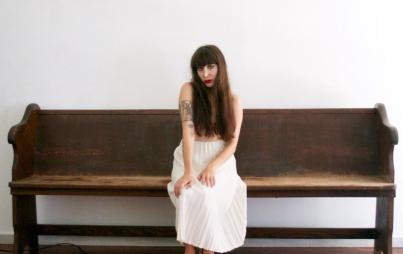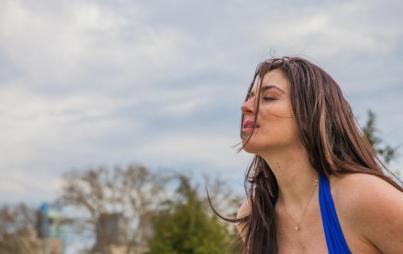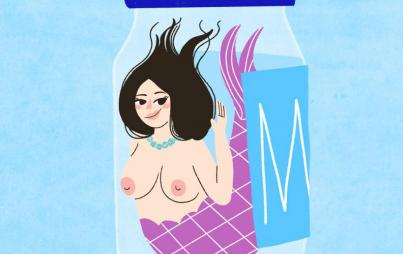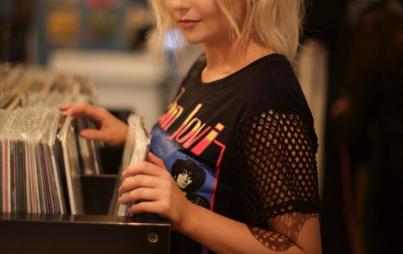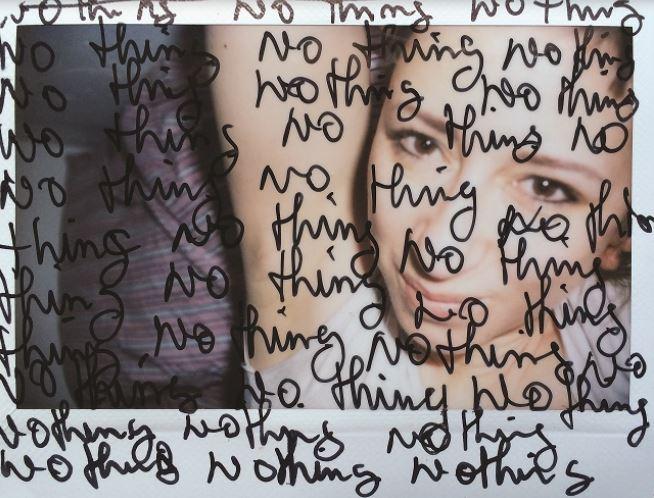
French-born mixed-media artist Angèle Lebert is a creative powerhouse. She unapologetically incorporates her own sexuality into her projects, whether they be performance art, paintings, photographs, videos, dance, or a combination of all of the above. Lebert calls her body of work "self-fiction" inspired by her intimate and erotic life as a woman. She's managed to triumph over tragic events and turn difficult emotions into an art form.
I caught up with her to talk about her intimate, erotic art and the life that's inspired it.
What was your childhood like?
I believe a woman's childhood is her foundation. But my childhood has a large gap—I have total amnesia of the first seven years of my life. This is part of the reason I focus on representing the connections between childhood and a woman's desire in my art.
Where were you born?
In Paris. My first memory is at age seven, when my mother tried to commit suicide in front of me. The only traces of memories I have before then come from the photographs my father took during that time. He finally gave them to me very recently, for my 42nd birthday. I look so happy and joyful before the trauma. I think I was probably an innocent, cheerful little girl until my mother's suicide attempt. Then the story changed.

That's terrible. How did it affect you?
I became a very responsible child in charge of her mother for 10 long years. But the incredible and wonderful thing is that at age 17, I reached a turning point. It happened when I drew myself, standing naked in front of the mirror with a charcoal in my hand. At that precise moment, I became intimate with myself. I was born again. I finally looked at myself as an erotic dimension. That day, I also took a photograph of myself with a Polaroid camera. Drawing and photography have always worked together for me—like reality and fantasy. Since then, I've taken one Polaroid of myself every morning. You might say that I regained my freedom through art.
Where did you hone your craft?
After I graduated from high school, I worked with a painter for one year. He was my teacher and my lover. Then I attended university. I graduated with a Master's degree in Visual Arts from the École Nationale Supérieure des Beaux-arts in Paris and a PhD in Aesthetics of Photography from the University of Paris VIII. My PhD was on Erotics and Politics. In addition, I graduated as an Associate Professor of Arts from the French National Ministry of Education with the "Agrégation," a highly competitive examination for positions in higher public education. Since the age of 20, I've taught art in various places: colleges, universities, mental health hospitals, schools of visual arts. I'm always totally engaged in whatever I'm doing. I believe making art and teaching art are linked; it's all about life.
 How did your studies lead to your career, which often mixes art and dance?
How did your studies lead to your career, which often mixes art and dance?
They gave me the necessary tools to be a mixed-media artist. I work with drawing, painting, photography, and video, and I also perform. I write for academic publications about the link between the erotic and politics, in addition to doing artistic and autobiographical writings. I studied with artists like John Coplans, Ken Lum, and Vladimir Velickovic. I'm thankful to have had the opportunity to work with them. The experiences were very strong.
But there are also artists I've never met personally whose art changed my life. Like choreographer and dancer Pina Bausch. When I discovered her work in my twenties I didn't understand then how much she was transforming me. I just felt it. It was emotional, irrational, and deep. What was usually hidden from the gaze was all right there: the unpresentable, the unsayable, the ugly, and the beautiful were there in the bodies. The past and the present were acting together. At the same time I also discovered the photographer Nan Goldin. I felt the same way when I saw her visual diary, "The Ballad of Sexual Dependency." They both opened doors that represented intimacy to me. They became my family.
What other artists touched you?
I was always very fond of the paintings of Frida Kahlo, Caravaggio, and Rembrandt—for his paintings with his wife Saskia. I also discovered Francesca Woodman's photographs when I was a teenager. I saw a lot of movies, too: Ingmar Bergman, Pasolini, and Truffaut. All of these artists' intimate lives can't be separated from their art. Their work tells their story: their love, their tears, their fear, their power, their dissidence, their paradox, their loneliness, the society they were living in.
Dance also plays a big part in your work. When did you study it?
I began ballet at five and stopped at 16. After that, I studied dance in other disciplines: African dance, jazz, hip-hop, tango, salsa, and more recently West Coast swing and country. I use dance in my performances in an experimental way. I play with the stereotypes of both gender and eroticism. I really enjoy collaborating with a choreographer and respecting the seriousness of the dance, but at a certain point, I deflect it, too. Since I'm not a professional dancer, I combine the erotic power of the dance with the vulnerability of my body. My performances are a key to read my pictures.
How would you describe your art?
My art is all about intimacy. But what is intimacy? What have you done? What are you doing with your intimate life? This question is mine but I also make it yours. When a man is part of my life, he will be at the heart of many of the pictures I create. His intimacy with me will be photographed, drawn, danced. His words will become my words when I perform. The way he comes, the way he loves me, or hates me. It's important he feels comfortable with this.

Your work is deeply personal. How did you become brave enough to bare the most private aspects of yourself artistically?
I'm asked this question very often, not only about the sexual aspects of my art but also because I share with the audience such intimate moments. I'm strong and vulnerable at the same time. It's not really a choice, though. I can't do it differently. For me, it's all or nothing. I'm telling a story with pictures. Sexuality is part of it—beautiful or not, it's part of the story. I've never felt embarrassed about it. I have a simple relationship with it: When I love or have a desire for a man, I want to touch him not only physically but on paper with my charcoal or with my camera. My eyes are like virtual hands: They caress, they feel.
Why did you leave Paris?
I wanted to begin something new in a new place. So I came to New York in 2013 to end my series "The Cycle of Fuck" and to introduce a new piece in my next series, "The Cycle of Love." That's exactly what I did. My two last pieces were "Fucking Adam!" and "Je t'aime Je t'aime." New York is a very attractive city for the arts. It has a creative energy that's unique, but it's a hard city, too. There's a lot of competition and it's expensive, but still, after so many years in Paris, it was good to be in such a contemporary city of art. I also wanted to work with performers that you can only find in New York City.
Which one of your works is your favorite?
That's a hard question because my work is a process of my life. Probably "Fucking Adam!" It's a significant piece not only because it completes "The Cycle of Fuck" but because it is a synthesis of everything I've done in the last 20 years. It's a fairy tale for adults blending reality and fantasy with drawings, paintings, video, and performance. I worked with several great artists for that piece: Adam Berlin, Antonio Ramos, Jeff Michael Smith, Craig Marsden, and Dan Eberle. It was a very special experience. The show took place in my loft, where I live and work. By coming to the performance, the audience entered my intimate space, both physically and emotionally.

What are you working on right now?
My new show is called "Love & Tyranny." It's inspired by the life of my Jewish grandfather during the Second World War.
What do you hope people experience from your art?
What they will hopefully take away from my work is a part of themselves, something they can consciously rediscover because of the emotional impact they experienced . . . discovering pieces of themselves through me.



